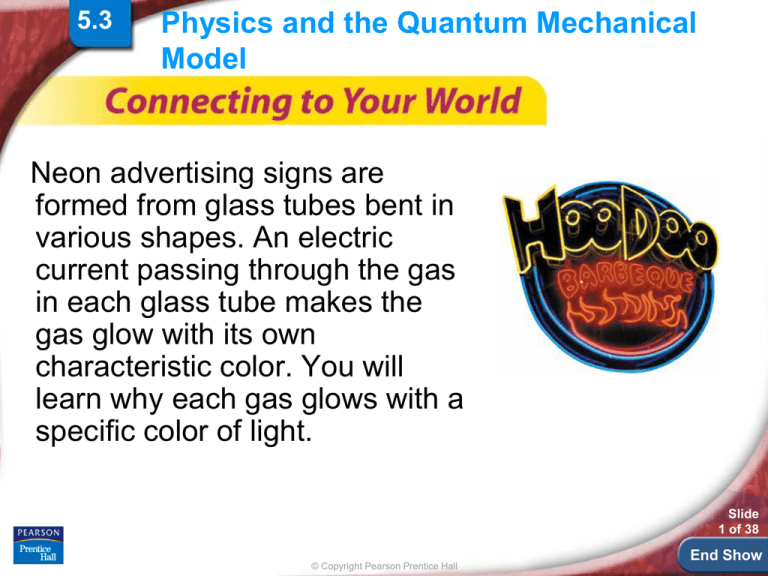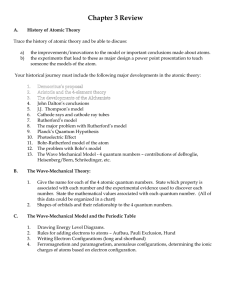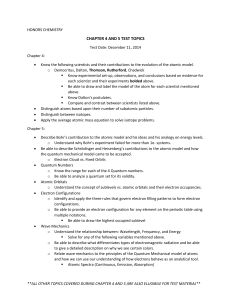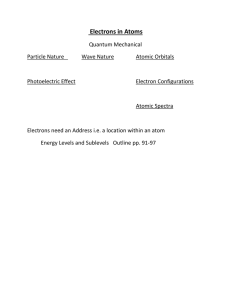
5.3
Physics and the Quantum Mechanical
Model
Neon advertising signs are
formed from glass tubes bent in
various shapes. An electric
current passing through the gas
in each glass tube makes the
gas glow with its own
characteristic color. You will
learn why each gas glows with a
specific color of light.
Slide
1 of 38
© Copyright Pearson Prentice Hall
End Show
5.3
Physics and the Quantum
Mechanical Model
>
Light
The wavelength and frequency of light
are inversely proportional to each other.
The product of the frequency and
wavelength always equals a constant (c), the
speed of light.
Slide
2 of 38
© Copyright Pearson Prentice Hall
End Show
5.3
Physics and the Quantum
Mechanical Model
>
Light
• The amplitude of a wave is the wave’s height
from zero to the crest.
• The wavelength, represented by (the Greek
letter lambda), is the distance between the
crests.
• The frequency, represented by (the Greek
letter nu), is the number of wave cycles to
pass a given point per unit of time.
• The SI unit of cycles per second is called a
hertz (Hz).
Slide
3 of 38
© Copyright Pearson Prentice Hall
End Show
5.3
Physics and the Quantum
Mechanical Model
>
Light
According to the wave model, light consists of
electromagnetic waves.
• Electromagnetic radiation includes radio
waves, microwaves, infrared waves, visible
light, ultraviolet waves, X-rays, and gamma
rays.
• All electromagnetic waves travel in a vacuum
at a speed of 2.998 108 m/s.
Slide
4 of 38
© Copyright Pearson Prentice Hall
End Show
5.3
Physics and the Quantum
Mechanical Model
>
Light
Sunlight consists of light with a continuous range
of wavelengths and frequencies.
• When sunlight passes through a prism, the
different frequencies separate into a
spectrum of colors.
• In the visible spectrum, red light has the
longest wavelength and the lowest frequency.
Slide
5 of 38
© Copyright Pearson Prentice Hall
End Show
5.3
Physics and the Quantum
Mechanical Model
>
Light
The electromagnetic spectrum consists of
radiation over a broad band of wavelengths.
Slide
6 of 38
© Copyright Pearson Prentice Hall
End Show
5.3
Physics and the Quantum
Mechanical Model
>
Atomic Spectra
Atomic Spectra
What causes atomic emission spectra?
When atoms absorb energy, electrons
move into higher energy levels. These
electrons then lose energy by emitting
light when they return to lower energy
levels.
Slide
7 of 38
© Copyright Pearson Prentice Hall
End Show
5.3
Physics and the Quantum
Mechanical Model
>
Atomic Spectra
A prism separates light into the colors it contains.
When white light passes through a prism, it
produces a rainbow of colors.
Slide
8 of 38
© Copyright Pearson Prentice Hall
End Show
5.3
Physics and the Quantum
Mechanical Model
>
Atomic Spectra
When light from a helium lamp passes through a
prism, discrete lines are produced.
Slide
9 of 38
© Copyright Pearson Prentice Hall
End Show
5.3
Physics and the Quantum
Mechanical Model
>
Atomic Spectra
The frequencies of light emitted by an
element separate into discrete lines to give
the atomic emission spectrum of the
element.
Mercury
Nitrogen
Slide
10 of 38
© Copyright Pearson Prentice Hall
End Show
5.3
Physics and the Quantum
Mechanical Model
>
An Explanation of Atomic Spectra
An Explanation of Atomic Spectra
How are the frequencies of light an atom
emits related to changes of electron
energies?
Slide
11 of 38
© Copyright Pearson Prentice Hall
End Show
5.3
Physics and the Quantum
Mechanical Model
>
An Explanation of Atomic Spectra
In the Bohr model, the lone electron in the hydrogen
atom can have only certain specific energies.
• When the electron has its lowest possible energy,
the atom is in its ground state.
• Excitation of the electron by absorbing energy
raises the atom from the ground state to an
excited state.
• A quantum of energy in the form of light is emitted
when the electron drops back to a lower energy
level.
Slide
12 of 38
© Copyright Pearson Prentice Hall
End Show
5.3
Physics and the Quantum
Mechanical Model
>
An Explanation of Atomic Spectra
The light emitted by an electron moving
from a higher to a lower energy level has
a frequency directly proportional to the
energy change of the electron.
Slide
13 of 38
© Copyright Pearson Prentice Hall
End Show
5.3
Physics and the Quantum
Mechanical Model
>
An Explanation of Atomic Spectra
The three groups of lines in the hydrogen
spectrum correspond to the transition of
electrons from higher energy levels to lower
energy levels.
Slide
14 of 38
© Copyright Pearson Prentice Hall
End Show
Physics and the Quantum
Mechanical Model
>
An Explanation of Atomic Spectra
Animation 6
Learn about atomic emission spectra and how
neon lights work.
Slide
15 of 38
© Copyright Pearson Prentice Hall
End Show







